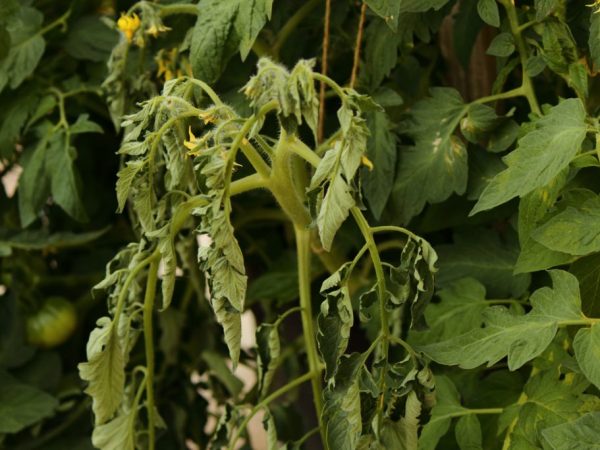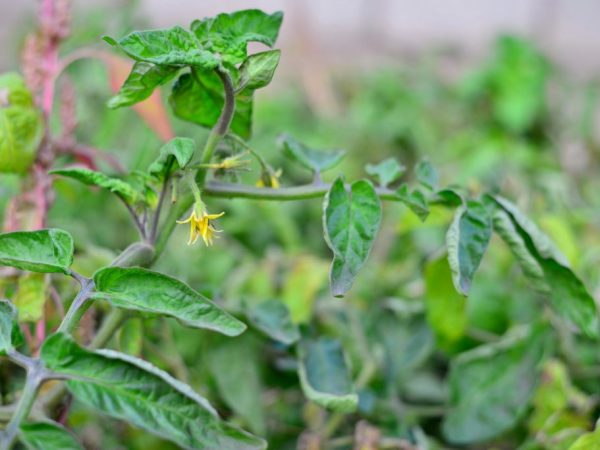Leaves of tomato seedlings wither: causes and solutions to the problem
Growing seedlings is a very crucial stage. Healthy, strong seedlings are well received in a permanent location. Plants grow that are able to give a good harvest of tomatoes. Sometimes in the process of growing something goes wrong, and the leaves of tomato seedlings wither. In such a situation, it is important to find the cause and do everything necessary to prevent it from dying.

Leaves of tomato seedlings wither: causes and solutions to the problem
The main causes of wilting plants
In order not to say goodbye to the idea of growing tomatoes in your own garden, you first need to find out why the tomato seedlings wither and fall. By identifying the causes, you can help plants restore their former health.
Among the main reasons for wilting are:
- violations of agricultural technology;
- infection with diseases.
Often it is poor care and oversight during cultivation that leads to the fact that tomato seedlings wither. You should also not exclude disease infection from the causes of tomato wilting, even such young plants can suffer from this. If you find out in time from what the seedlings began to wither, then the situation can be improved and it will not be difficult to save young bushes.
Violation of agricultural technology
Unsuitable soil
Properly selected soil is of great importance. In the event that the seeds are sown in heavy clay soil or it has a low pH and acidity, young plants begin to wilt. And after a while they dry up and die. This is due to the fact that with a heavy compacted soil mixture, gas exchange is disturbed, the root system does not develop well, the plant does not receive nutrients. And a low pH level leads to a high level of salts in the soil, which attract trace elements, which does not allow the seedlings to receive adequate nutrition.
Decision
In such a situation, the first thing to do is to transplant it into suitable soil. Well-drained, neutral soil with a pH of 5.5-7 is suitable for tomatoes. The composition should include:
- leafy land;
- low peat;
- agroperlite or vermiculite;
- sand.
You can purchase a universal soil mixture. Before transplanting, it is worth disinfecting it so as not to endanger the infection. The earth must be spilled with a weak solution of potassium permanganate or dried in an oven at a temperature of 90 ° C for half an hour. The sprouts are carefully transplanted into the prepared soil and lightly watered.
Thickened plantings
With ignorance or fear that the seeds may not sprout well, an inexperienced gardener has a desire to plant more seeds in a container. As a result, a large number of tomatoes grow in containers. Plants are thickened, they lack light and space, they begin to stretch. The stems become thin and the leaves wither.
Decision

Plants need to remove excess greenery
To save tomatoes, it is enough to thin them out or cut them down.If such an amount that has sprouted is not required, then simply cut through the planting, removing weaker plants. In the case when each bush is valuable, then a pick is carried out and some of the plants are transplanted into additional containers.
Insufficient lighting
At the stage of growing seedlings, adequate lighting is a very important factor. When sowing seeds early in late winter or early spring, a lack of light is a very common problem. Since the daylight hours are still short, and for the growth of healthy seedlings, at least 8-10 hours of lighting is required. In poor lighting, the stems become thinner, moisture and nutrients do not move well through the vascular system, and as a result, the lower leaves of tomatoes begin to wither, and then the rest.
Decision
To improve the situation, you need to keep tomatoes on the most lighted windowsill. The south or east side is better. But a greater effect can be achieved if you make the backlight with photo lamps or fluorescent lamps. They provide lighting that is as close to natural as possible.
Temperature violation
Despite the fact that tomatoes love heat, high temperatures often lead to the fact that the plants are closed and die. Temperatures on a windowsill or greenhouse above 35 ° C can cause irreversible damage.
Lowering the temperature below 15 ° C has a no less detrimental effect. When the temperature is low, tomatoes are unable to absorb nutrients. Cessation of admission is observed:
- phosphorus at temperatures below 15 ° C;
- nitrogen at temperatures below 10 ° C.
Decision
It is necessary to adjust the temperature to the optimum temperature for tomato growth, and it should be between 18-25 ° C.
High temperatures are rare during the growing season. But, if overheating has occurred, the room where it grows should be ventilated in order to stabilize the temperature regime or remove the seedlings to a more suitable place.
Provide additional heating at low temperatures. You can move the seedlings to a more suitable location. Make sure that there are no drafts, which can also cause the temperature to drop.
Improper watering
Improper watering can also cause wilting. Tomatoes are negatively affected by both lack and excess of moisture. Even short-term drying out of the soil leads to wilting of the leaves. But a long absence of watering can completely destroy the seedlings.
Overflow can be just as harmful. An excess of moisture leads not only to lethargy, but also to rotting of the roots. Also, the abuse of watering contributes to the development of pathogens and fungi.
Decision

Improper watering can be detrimental to tomatoes.
If the seedlings have wilted due to insufficient watering, it will be enough to gently water them to restore them. What you should not do is to water the seedlings immediately. It is necessary to moisten the soil gradually in several stages. When the correct regular watering is resumed, the condition of the plants is completely stabilized.
If the tomatoes wilted and lay down due to a strong overflow, you should proceed as follows:
- Free sprouts from wet soil
- Transplant into slightly moist, fresh soil
- Drizzle gently over each plant with a weak solution of magnesium permanganate
- Treat the leaves with a solution of Epin, or another growth stimulant.
Fertilizer overdose
Tomatoes on the windowsill need feeding for good growth. But an overdose brings with it negative consequences. Most often, nitrogen overdose occurs. It is manifested by the compaction of the stems, wilting of the leaves and their twisting. And also in the case of applying a large amount of nitrogen fertilizer, the roots may burn, which will also lead to the fact that the tomatoes will begin to wither.
Decision
There are two options for neutralizing excess nitrogen:
- Carefully remove the top soil ball and replace it with a new one. Which is pre-mixed with sawdust.Spill the seedlings with clean water.
- Transplant seedlings into fresh, moist soil. Spray plants with Epin.
With a severe burn of the roots, it is not always possible to save the tomatoes.
Disease Infection
Tomatoes at the seedling stage can also be affected by diseases. The infection is caused by seeds or soil. And not proper care stimulates their development. Most often, the reason that the leaves wilt are the following diseases:
- Fusarium;
- blackleg.
Fusarium wilting (fusarium)
A fungal disease that affects both adult bushes and young seedlings. Fusarium is caused by fungal bacteria of the genus Fusarium. Infection occurs with spores, which retain their vital activity in the soil for several years. With fusarium, the root is primarily affected, and as a consequence, it can be observed that the seedlings become sluggish and fall.
Decision
The disease is complex and the fight against it does not always bring a positive result. If Fusarium is diagnosed, tomatoes are treated with Trichodermin. Spray the solution over the sheet. And they also spill soil for them. Processing is carried out 2-3 times, every 10 days.
Unfortunately, treatment does not always help. The best way to avoid fusarium disease is to decontaminate the soil and seeds before planting.
Blackleg
A fungal disease that often suffers from tomato seedlings. Infection comes from the ground. When infected, the stems at the bottom become thinner, the lower leaves turn yellow, the seedlings fall. It develops quickly, affects all seedlings in a short time. Stimulates disease development: excess moisture
- thickened landings;
- poor ventilation;
- low temperatures;
- belated pick.
Decision
If the first diseased seedling is found, then there is a chance to save part of the seedlings. To do this, do the following:
- Diseased plants with a clod of earth are removed.
- The seedlings that grew next to the affected are also removed.
- The place where the diseased tomatoes were treated with a solution of potassium permanganate (1.5 g per 10 l of water).
The best way to avoid a blackleg infection is through preventive measures.
- The soil is disinfected (with potassium permanganate solution, boiling water).
- Seeds are sown in special cassettes.
- Seedlings are treated with Previkur (twice before transplanting into the ground or greenhouse).
- do not allow seedlings to thicken, thin out and pick in time.
Conclusion
There are many reasons that cause wilting of leaves on tomato seedlings. Most often, such a problem arises due to a violation of agricultural technology, which pulls and other consequences unfavorable for tomatoes. If you find them in time, it is possible to help the plants and prevent their death.


